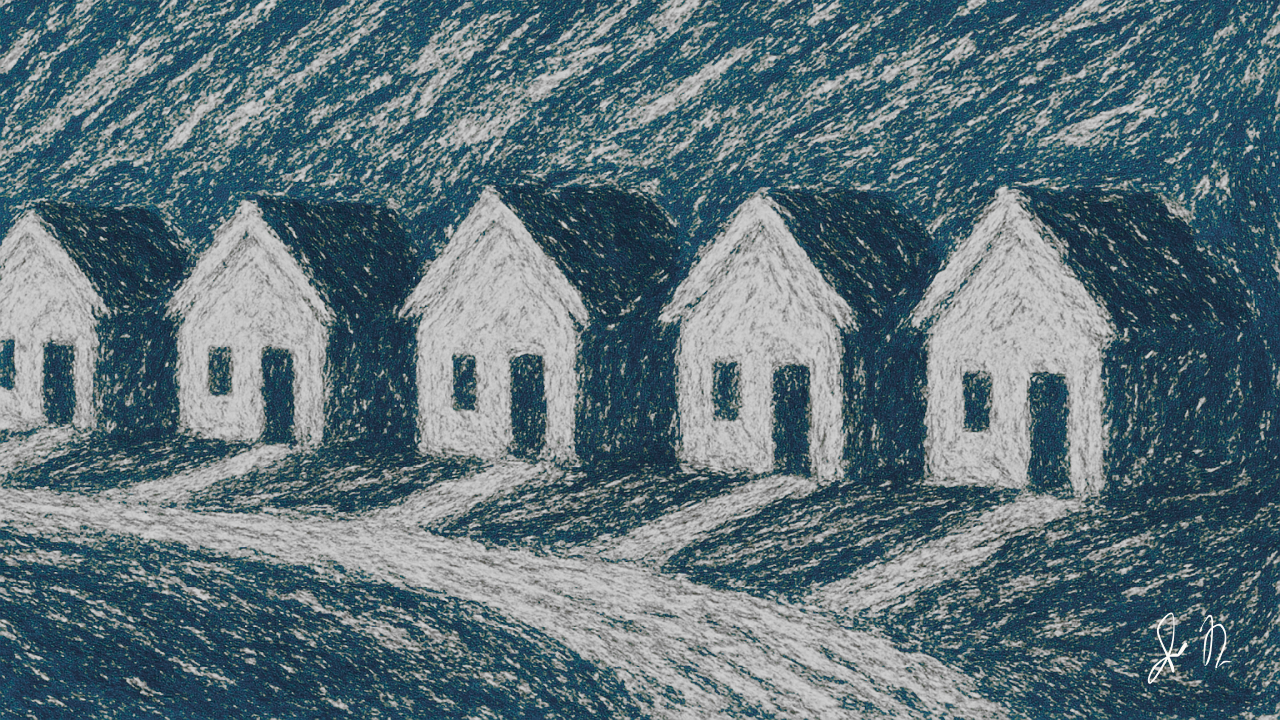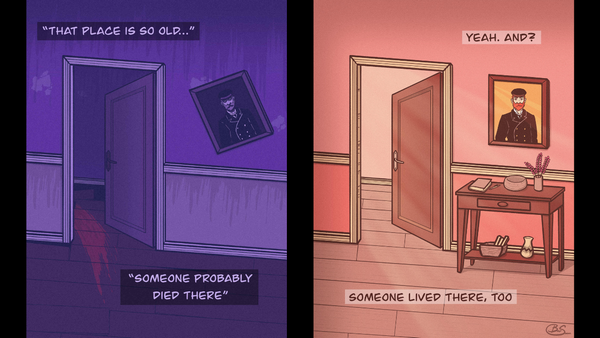Little Good People
She was paid to invent the perfect neighbors. Now she can't prove who's real.

Stories are a lie. Renee Mallory repeated this mantra to herself over and over again as she sat in the interview room at Heirloom Redevelopment. It was the only thing distracting her from the woman sitting across, wearing a blazer that could catch Renee up on her rent if she could somehow pawn it….
“Your portfolio shows real range,” the woman said, tapping a tablet. “Pharma copy, lifestyle brands…my goodness, a viral campaign for ethical diamonds.”
“Yeah, well, that was before the lawsuit,” Renee said.
“We know.” The woman smiled. “We appreciate honesty here at Heirloom.”
The woman slid the tablet across the table. On it, a map dotted with properties, each tagged with family names and star ratings. The Goodalls at 412 Maple: 4.7 stars. The Nguyens at 308 Birch: 4.9 stars.
“Our business is revitalizing post-industrial communities,” the woman explained. “Making them attractive to remote workers, young families. But perception drives reality, no? We need resident testimonials that capture the right feeling.”
“Wait, testimonials from actual residents? But they don’t live there yet.”
“Testimonials from potential residents. You’ll be writing aspirational narratives. Believable ones.”
That, Renee understood. She was being asked to invent people. Make shit up, essentially. Wouldn't be her first time.
“The position pays seventy-five thousand, full benefits, remote-friendly after the first month.” The woman produced an NDA thick as a novella. “Though you’ll need to sign this first. Standard protection for our methodologies.”
Renee winced at that, but the cold truth was that her own personal methodologies had led to an empty refrigerator, an eviction notice folded in her purse, and her ex-husband’s lawyer demanding documentation she couldn’t afford to compile.
“What kind of families would I be…inventing?” she asked.
“The good kind. Little good people living their best lives.”
The pen felt heavier than it should. Renee signed her name four times, initialed seven more. Each signature smaller than the last, as if she was already disappearing.
That night, Renee created the Goodalls. Tom, an aerospace engineer who’d traded Boeing for beekeeping. Marla, who ran virtual yoga classes from their converted barn. Their daughter Emma, precocious but not annoying, who’d started a neighborhood newsletter at age nine.
She gave each of them struggles—Tom’s father had Alzheimer’s, Marla had miscarried twice—but she also made these troubles part of their ongoing story, overcome by the community’s support. She uploaded their testimonial to Heirloom’s content management system at 2:00 a.m sharp.
Then, just a few hours later, she received her first email from corporate:
FROM: Analytics@Heirloom.io
SUBJECT: Performance Metrics
BODY: Goodall family narrative achieved. Bonus approved.
By the next morning, a lifestyle blog had picked up the story. The Goodalls were real enough to trend.
Six weeks in, Renee had populated an entire town. The Nguyens ran a sustainable coffee roastery. The Johnsons had left Chicago after their son’s asthma improved in the cleaner air. The Kowalskis hosted Polish cooking classes every third Sunday.
She worked in solemn silence from her studio apartment, surrounded by character sheets and timelines out of a tabletop game. Each family had a spreadsheet: birthdays, allergies, the names of pets they’d lost. She knew that Kevin Johnson preferred bass to trout, that Linda Nguyen was learning Mandarin from her mother-in-law, that old Mr. Kowalski hummed Chopin while gardening.
The work felt like playing God with dollhouses, except the dolls paid her bills.
Then Google Maps...happened. Renee had been writing about the Goodalls’ new chicken coop, how Emma had named each hen after a constellation, just details to flesh out the monthly newsletter. But when she checked the map for street reference, she spotted a small structure behind 412 Maple, exactly where she’d placed it.
At first, she thought she was hallucinating thanks to a definitive lack of sleep. But no. She blinked and checked the satellite view. It was clear as surveillance. She zoomed in further. The coop had a star chart painted on its side.
That was actually impossible. She made that coop up.
Renee’s hands shook as she refreshed the page. Same image. She checked the date stamp: yesterday. But she’d only written about the coop this morning. This morning.
The rational explanation came quickly. Heirloom must’ve hired contractors, people who built what she wrote to stage photos. Viral marketing requiring physical props, after all. Though her salary seemed low for a budget that also included construction.
And again, she wrote about the coop this morning. How could they have built it last night?
Freak coincidence. Freak coincidence. That’s all it is.
To calm herself down, she went back to writing. The Johnsons’ son had recently joined Little League. The Nguyens adopted a three-legged cat named Schrodinger. Details accumulated like snow, each one making the fictional town heavier, more real, more buried in plausibility.
Her phone buzzed with several notifications in a row. The Goodalls had an Instagram now, probably set up by Heirloom with staged photos. Emma’s newsletter had real-life subscribers. The Polish cooking class had a waiting list.
Renee made herself a new rule: Don’t search for anyone online. Don’t look too close. Write the stories, collect the checks, pay the rent. And honestly, that's all she had the power to do, anyway.
But Renee had started dreaming about these people now. Tom’s voice explaining bee colony collapse. Marla’s laugh during warrior pose. Emma reading her newsletter aloud, stumbling over the word “perseverance.”
She woke with their names in her mouth, thick as honey.
The company flew Renee out for a “site visit” in the middle of month three. Said she needed to see the communities she was helping build. The plane ticket arrived with no return date.
Hammond, Ohio. A town that had lost its tire factory, its hope, and half its population, mostly in that order. Heirloom’s revitalization centered on a seven-block radius downtown, fresh paint over rotting wood.
Rene's handler, Derek, had the aggressive cheer of someone paid to believe in billionaires. “Wait till you see what we’ve accomplished, Renee. Your narratives really brought this place to life, I'm so impressed with your work.”
They turned onto Maple Street. The house at 412 looked exactly as she’d described it in the testimonials. Not similar. Exact. The weathervane shaped like a biplane (Tom’s tribute to his Boeing days). The kitchen window herbs dying in specific patterns (Marla always forgot the basil). The front door’s scratches at shin height (their previous dog, Kepler, who’d died last spring). Even the welcome mat had a Thanksgiving pun that Renee had only thought about, never actually wrote down.
“I need some air,” Renee managed.
“Take your time,” said Derek. “Oh, but the community meet-and-greet starts at four.”
Ignoring him, she walked toward the house like approaching a dream she’d had about drowning. Through the window, she counted the copper pots on hooks, stared at the Swedish coffee maker she’d invented for Tom’s birthday, caught a glimpse of Emma’s newsletter drafts spread across the table, almost tripped over a memorial for Kepler in the backyard.
The front door opened, causing Renee to jump without her feet.
Marla Goodall stood in the frame, appearing exactly as Renee had imagined. Strawberry blonde hair in a messy bun, paint under her fingernails, that small scar above her left eyebrow from a childhood fall Renee had written in her notes but never submitted.
“You must be the writer from Heirloom,” Marla said, eyes attentive but not unkind. “We’ve been expecting you to show up at some point.”
Renee’s mouth went dry. “H-how did you know?”
“I don't know, you have that writer look. Like you’re seeing ghosts in everything around you.” Marla laughed in the exact pitch Renee had heard in her dreams. “Hey listen, I’m making sun tea. Tom’s at the hardware store, but Emma would seriously love to meet you. She has a ton of questions about the newsletter’s reach.”
Swallowing everything but her humanity, Renee entered the house without a word.
Inside, everything was wrong in its rightness. The furniture distressed in specific places. Photo albums on shelves, spines cracked at particular pages. The smell of Tom’s preferred coffee brand mixing with Marla’s lavender lotion.
“How long have you lived here?” Renee asked, trying not to sound too panicked, but her hands were practically seizing up.
Marla tilted her head. “Hm…you know, it’s the strangest thing. Sometimes I feel like we just got here, other times like we’ve been here forever. Tom says it’s the adjustment period. Moving does that to your sense of time.”
Emma appeared in the doorway, nine years old and luminous with purpose. “Hi! Are you here about the newsletter?! Oh, oh! I have over 200 subscribers now!”
“That’s wonderful,” Renee said, though she’d written that number into existence last Friday.
“I’m thinking of adding a science corner. Did you know that chickens can recognize over 100 faces? Including human faces?” Emma pulled out a notebook covered in star stickers. “Orion—that’s our Buff Orpington—she knows all the neighbors now.”
Renee made herself breathe. “Sorry, I should go. Not feeling well.”
“But you’ll come to the block party tonight?” Marla touched her arm, and her hand was warm, real, impossible. “Everyone will be there. Mr. Kowalski promised to bring his famous pierogi.”
“Everyone,” Renee repeated.
“All the good people,” Emma said, and her smile was equal parts proud and precious.
Renee didn’t go to the block party. She drove her rental car to the town limits, then past them, until Hammond was just lights in the rearview. But at the motel, her credit card was declined.
The text from her bank: “Account registered to R. Mallory, 412 Maple Street, Hammond, OH.”
She called them from the motel parking lot. The representative was polite but firm. According to their records, she’d updated her address weeks ago. They had documentation. Her signature.
Her phone showed five missed calls from a number she didn’t recognize. The voicemail: “Renee, it’s Tom. Sorry I missed out on meeting you, and for calling you out of the blue like this, but Marla’s worried. You left so suddenly. Emma saved you a piece of pierogi. Come home when you’re ready.”
Home.
She checked her email. Her inbox had reorganized. Messages from Derek at Heirloom filtered into a folder labeled “Neighbors.” Her ex-husband’s lawyer had received a change of address form. Her LinkedIn showed her as “Community Narrative Specialist at Heirloom Lane.”
Heirloom Lane. Not Heirloom Redevelopment.
The map application on her phone refused to navigate anywhere except back to Hammond. So she drove through the night instead, following road signs, paying cash for gas with bills she’d hidden in her laptop bag. By dawn, she’d reached Heirloom’s corporate office in Columbus.
The building was glass and steel and little else. She’d expected security, at least some kind of resistance. But the doors opened to her keycard—when had she gotten a keycard? The elevator had no buttons, but it knew her floor.
The server room was in the basement, filled with banks of machines humming with purpose. She found the terminal easily; her login worked like it was waiting for her. The file structure spread before her like a map of synapses, each family a node, each connection a street, each story a house being built in real-time. The Goodalls’ file was massive now, spawning subdirectories: Emma’s school records, Tom’s work history, Marla’s medical files showing two miscarriages and a successful pregnancy.
But there was another file, still rendering: R_MALLORY_V2.
She opened it.
It was her own life, rewritten. Parents who still called every Sunday. The promotion she’d never gotten. The marriage that hadn’t failed. A son named Oliver who played Little League and loved dinosaurs. A house at 414 Maple with a mortgage in good standing. Her body, ten pounds lighter, the stress lines edited from her face.
A better version. A good person living her best life.
The system prompt blinked: INTEGRATE? Y/N
It all made so much sense now. Heirloom didn’t just create neighborhoods. It replaced them. Every story she wrote overwrote something true, someone real. The town revitalization was total bullshit. It was just an excuse to overwrite what came before.
And now the system wanted to overwrite her.
Her phone rang. She didn’t answer it, but the call clicked on anyway. Derek’s voice: “Renee, we know you’re in the building. This doesn’t have to be difficult.”
“What happens to the people getting overwritten?” she asked.
A deep sigh from Derek. “They become something new, Renee. They become better. Like the stories you wrote. Isn’t that what you wanted when you wrote them? To fix things? To make them good?”
The word “good” echoed in her head, then materialized as a new memory. The word hanging over the Goodalls’ invented table. The Nguyens’ three-legged cat. Mr. Kowalski’s pierogi, recipes inherited from a grandmother who’d never existed. But maybe they did exist. Because of her.
Her finger hovered over Y.
She hesitated. Tried to think of another word to replace “good.” Only one came. Oliver. The son she’d never have, playing Little League in a town built from lies. Growing up in a story someone else would have to maintain. Believing his mother was good because “Derek” said so.
Without thinking, Renee deleted the core drive. Not just her file. All of it. Every family, every house, every too-good-to-be-true lie. The system fought her with passwords, warnings, Derek’s voice over the phone promising lawsuits and even jail time.
But she ignored all of it. The deletion took less than 20 minutes, long enough to remember every family she’d built and apologize to each one as their files disappeared in rapid succession. The Goodalls went last, and she swore she felt Marla’s hand on her shoulder one last time, along with Emma’s voice asking her a question she couldn't quite hear.
The lights went out. In the darkness, Renee heard the building’s bones settling, like a house adjusting to new ground after an earthquake.
Renee woke in her apartment. Her real apartment, with its water stains and expired lease. Her phone showed no record of Heirloom. Her bank account had sixty-five dollars. The eviction notice was still folded in her purse.
She checked her phone. Hammond, Ohio was just another dying town. No Goodalls. No Nguyens. No testimonials. Renee laid down and put her phone to rest. She heard a knock on the door that jolted her back awake. Cautiously, she walked over to see someone had left a padded envelope on her welcome mat.
She opened it. No return address. Inside: a child’s notebook covered in star stickers, pages filled with attempts at a newsletter. The masthead read “Emma’s Good News,” and below that, in slow, meticulous cursive: “Volume 1.”
The first article was about chickens recognizing faces and how memory works. It ended with a few sentences about the way love persists even when its object of affection disappears.
The last line stuck out the most. Even dead things stay real in the hearts that saw them live.
Renee sat at her desk, no longer thinking about how behind she was on rent or what kinds of new people she’d invent. She just whispered to the empty walls, to the ghosts in the machine, to the little good people who’d never been...
“You were real enough to me.”
And somewhere in Hammond, Ohio, in a house that never existed, a family that was never born sat down to dinner, said grace, and remembered Renee’s name.
Author's Notes:
As many of you frequent readers know, I love to dabble in stories that tackle gentrification from its most haunted extremes. For this one in particular, though, I set out to meditate on the nature of creation and authenticity, particularly as someone not too dissimilar from our tragic main character. Let's break this one down.
To be honest, I was nervous about this tale feeling too gimmicky. A story about fictional testimonials manifesting into reality? Even for me, that's a bit on the nose. But my main tactic was to always ground the premise in mundane descriptions. That is, I'm trying to anchor the supernatural horror in completely ordinary, relatable financial stress. That way the story can be all the more unsettling! So that means we don't start with a copywriter discovering her words become reality. Nope. The story begins with a down-on-her-luck job interviewee coveting a blazer that could pay her rent.
Well, technically the story begins with "stories are a lie," which becomes increasingly ironic as Renee's lies become more real than truth.
Anyway, one of the reasons I bill this as speculative fiction over a horror is in how the true terror here is economic precarity. Renee has $65 in her bank account and an eviction notice in her purse. Her complicity feels inevitable, even though $75k isn't life-changing money. It's survival money, which makes her choices feel grimly realistic to me.
And that's also why the gentrification metaphor is so prominent. I wanted to write a savage critique of "revitalization" projects that erase existing communities but even more explicitly than I have in the past where actual residents are being overwritten, not just excised. The little good people are replacements, rather than just fictional, in the same way we use social media to put more appealing wallpaper on our day-to-day lives.
Let's talk prose. I'm continuing to work on voice and restraint for my more commercial/upmarket stories. It's always a tricky balance to infuse literary tone with accessible flow, making sure lines have poetic weight without feeling "purple" and overwritten. On the second draft, our managing editor Natalia advised me to adjust some lines that skew closer to Renee's exhausted pragmatism. This was probably the best edit she gave on the entire story, and that's saying something.
Also, I've been asked a few times lately how to make these short stories (especially ones as short as this) feel as lived-in and real as they do despite such a limited word economy. And for me it comes down to what I sometimes call "The Uncanny Valley of Detail." Simply put, specificity is what sells a world. The chicken coop isn't just a chicken coop, it has a star chart. The dog's scratches are at shin-height. It's not just a coffee maker, it's a Swedish coffee maker. I don't want these details to be generic. I want them to be the kinds of things only an intimate observer would notice and point out.
Further, these compressed stories always need to be heavily scrutinized at the scene level. The section breaks need to jump forward just enough to show progression while maintaining momentum. The email from analytics, the maps update, the Goodalls introduction, all of it should feel like a revelation begging you to read at least one more paragraph.
I know I've gone back and forth when it comes to ambiguous endings, a constant topic of discussion here at Cetera. For this one, the ambiguity lies in the mystery behind Emma's notebook arriving after everything's been deleted. Which begs a few questions. Did Renee actually delete anything? How did everything just vanish? Did anything matter? Well, to be fair, the line "Even dead things stay real in the hearts that held them" suggests that creation, even false creation, has its own kind of permanence.
But I do think that the story's ending succeeds (at least enough for me) because it never lets Renee off the hook morally while also never judging her. We understand exactly why she takes the job, why she keeps writing even after the first sign that something is wrong. The gut punch lies in how easily any of us might do the same thing for a decent salary and some health insurance.
Jon Negroni is a Puerto Rican author based in the San Francisco Bay Area. He’s published two books, as well as short stories for IHRAM Press, The Fairy Tale Magazine, and more.
Support Cetera
Paid members get exclusive perks like bonus stories, the ability to comment, and more. Plus you'd be helping us keep the bills paid. You can check out the subscription tiers below, or you can leave a one-time tip if that works better for you.





